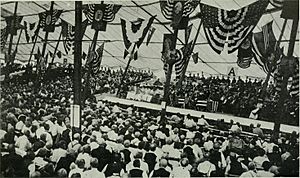1913 Gettysburg reunion facts for kids
Quick facts for kids 1913 Gettysburg reunion |
|
|---|---|
| Gettysburg National Military Park, Adams County, Pennsylvania in United States | |
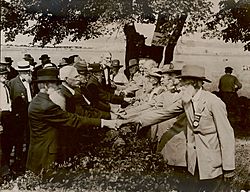
Old soldiers of the North and South clasping hands over The Angle in fraternal affection
|
|
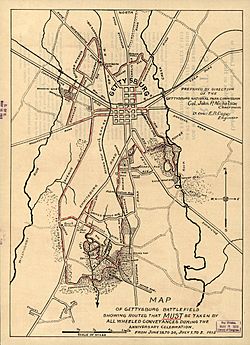
Gettysburg battlefield during the anniversary celebration
|
|
| Site information | |
| Owner | United States Department of War |
The 1913 Gettysburg reunion was a huge gathering of American Civil War veterans. It took place at the Gettysburg Battlefield to celebrate the 50th anniversary of the Battle of Gettysburg. From June 29 to July 4, 1913, over 53,400 veterans attended. This included about 8,750 Confederate soldiers. It was the largest meeting of Civil War veterans ever.
All soldiers who had finished their service with honor were invited. This included members of the Grand Army of the Republic (Union soldiers) and the United Confederate Veterans (Confederate soldiers). Veterans from 46 of the 48 states came, except for Nevada and Wyoming. Even though some worried about arguments between the North and South, the reunion was very peaceful. Many events showed friendship between former enemies. President Woodrow Wilson spoke on July 4. He said, "We have found one another again as brothers and comrades in arms, enemies no longer, generous friends rather, our battles long past, the quarrel forgotten—except that we shall not forget the splendid valor." This meant they were united again as Americans.
Contents
Planning the Big Reunion
After many smaller Gettysburg gatherings, people started thinking about a bigger event. In 1906, a reunion of the Philadelphia Brigade and Pickett's Division took place. During this event, a captured sword belonging to Confederate General Lewis Armistead was given back to the South.
In April 1908, General Henry S. Huidekoper suggested a 50th-anniversary reunion for 1913. He spoke to Pennsylvania Governor Edwin Sydney Stuart. Officials from the Gettysburg National Military Park and Gettysburg town met to discuss the idea. Governor Stuart also held meetings and spoke to the state government about it.
Getting Ready for the Event
On May 13, 1909, Pennsylvania created a special group called the Fiftieth Anniversary of the Battle of Gettysburg Commission. This group planned a "Peace Jubilee" and wanted to lay the first stone for a "Great Peace Memorial" on July 3.
In August 1912, the U.S. Congress approved $150,000 for the event. They also told the War Department to set up the camp. However, money for the memorial was not approved, so the "Peace Jubilee" plans were changed.
The camp location and an 8-acre spot for the Great Tent were chosen in 1912. The Gettysburg National Park Commission also painted fences, gun carriages, and signs. On April 13, 1913, the Pennsylvania commission finished the Pennsylvania State Memorial. They also sent out 40,000 invitations to veterans.
President Woodrow Wilson announced on June 28 that he would attend for a short time. States contributed a lot of money for the reunion. Pennsylvania gave $450,000, and other states added up to $1,033,000 in total.
Reunion Preparations and Services
The Pennsylvania commission had its main office in Gettysburg. They also had an office in Harrisburg. Special tokens and programs were made for those attending. These included badges and a souvenir program with poems.
The Pennsylvania Railroad added a telephone line between Gettysburg and Hanover. This helped them run many trains during the anniversary. Tolls on roads leading to Gettysburg were removed just in time for the reunion. This made travel free for everyone.
By February 1913, workers were drilling water wells for the camp. Hotels in nearby towns were quickly filling up. For entertainment, a facility was started in 1912 to show the Boston version of the Gettysburg Cyclorama. A black and white film called The Battle of Gettysburg was shown for the first time on June 26. This film has since been lost.
Local officials also made plans for the reunion. They made sure taxi fares in Gettysburg were fair, with a maximum of 50 cents.
Reunion Facilities

The War Department set up the Great Camp for the veterans. This huge camp had tents and support buildings. It stretched on both sides of Long Lane. The Great Camp included the Great Tent, which was 200 by 450 feet and had 13,000 chairs.
The camp provided tents for the veterans. It also had quarters for 1,466 War Department soldiers and 2,179 food service workers. There were 385 Boy Scouts from Washington helping out. In total, 57,198 people stayed and ate at the Great Camp.
The camp had a temporary U.S. Post Office. There were also many restrooms set up by the Pennsylvania Health Department. Near the Great Tent, there was an Emergency Station and two Comfort Houses. These provided water fountains. The Pennsylvania commission also set up a temporary morgue in the camp. A special platform was built on the Round Top Branch railway. This allowed veterans to get off steam trains right into the camp.
Health and Safety Measures
The state health department expected 100,000 people to visit Gettysburg. So, they took charge of medical and sanitation efforts from June 25 to July 25. They set up a field hospital at the Kurtz property. They also had six Comfort Stations in the town, including one at each railroad station.
The department tested the town's water wells. They also worked to prevent pollution in the water supply. The American Red Cross Society helped too. They had 14 small Relief Stations on the battlefield roads. These stations offered first aid and a place to rest. The Tuberculosis Dispensary in Gettysburg was also used as a Relief Station.
Military and Other Camps
A battery of the Third United States Field Artillery was at the Great Camp. Several companies of Regular Infantry were there too. Companies A-D of the Fifteenth United States Cavalry arrived on June 26. They helped guard the battlefield. They camped west of Seminary Ridge.
A "model Camp" for a Pennsylvania cavalry squadron was near the commission's Headquarters. Many people stayed at the Lutheran Theological Seminary at Gettysburg and Gettysburg College. This included the Pennsylvania Gettysburg Commission and Pennsylvania State Police. Governor Tener's staff also stayed in tents there.
Other camps included "Newspaper Row" for 155 journalists. This was north of the Gettysburg National Cemetery. Thirty Boy Scouts camped near Cashtown. They helped travelers on the road. Members of The Salvation Army camped at Stonesifer's Grove.
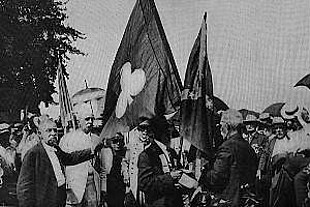
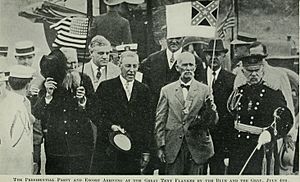

Reunion Events and Activities
The Commission planned a four-day series of events. Each day was dedicated to a different group.
The Great Camp opened for supper on June 29. Many veterans arrived early, especially those who traveled long distances. Over 21,000 people arrived that day. Two Confederate veterans from Culp's Hill arrived even earlier, on June 26. There were some initial shortages of food and supplies.
On June 30, the base of the 1912 Virginia Monument was dedicated. The rest of the monument was finished later.
Daily Highlights
- July 1: Veterans' Day included a speech by John Wanamaker. He was a major department store owner and a generous person from Philadelphia.
- July 2: Military Day featured a speech by a military officer. He suggested a stronger military, as tensions were rising in Europe. World War I would begin in July 1914. The Gettysburg Address was read aloud. The Virginia division was reviewed by their governor at Seminary Ridge. That night, Union veterans made a surprise visit to the Confederate side of the Great Camp. This led to joint parades and campfires.
- July 3: Civic/Governors' Day had 65 unit reunions. The statue of General William Wells was dedicated. A special Webb/Pickett flag ceremony took place at the Bloody Angle. This was at the same time of day as Pickett's Charge. Vice President Thomas R. Marshall, the Speaker of the House, and many other officials attended. In the Great Tent, Colonel Andrew Cowan suggested building a Gettysburg peace memorial. Fireworks lit up the sky at 9 pm. They included huge displays on Little Round Top.
- July 4: National Day saw the dedication of the Pennsylvania State Memorial. Eight statues had been placed there in April. President Woodrow Wilson arrived at 11 am. He traveled through the town and entered the Great Tent. He spoke about national unity. He left after the National Anthem was played.
At noon, a 5-minute silent tribute was held for "Our Heroic Dead." People stood still, and a bugle salute was played. Bells in Gettysburg tolled noon. Artillery fired periodically during the silence. From 5 am to 11 pm, over 7,100 cars used the national park roads as visitors left.
After the Reunion
About 12,000 veterans had already left on July 2 and July 3. The Great Camp began to be taken down right after the July 4 tribute. The hospital closed on July 5. The last veteran left on July 8.
An annual military training camp used some of the veterans' tents. This camp was for 250 college students. The Quartermaster headquarters closed on August 13. By August 15, almost the entire Grand Camp had been removed. A movie called United at Gettysburg was made about the reunion.
To remember the 1913 Gettysburg reunion, a colonial entrance was opened in May 1914 at the Seminary's Old Dorm. Only its concrete base remains today. In 1938, the Eternal Light Peace Memorial was built on Oak Ridge, north of Gettysburg.
The Congressional committee used the name Celebration of the Fiftieth Anniversary of the Battle of Gettysburg, but other organizations and officials used numerous other names:
· Celebration of the Semi-Centenary of the Civil War
· Gettysburg Celebration · Reunion Celebration at Gettysburg
· Gettysburg Reunion · Gettysburg Peace Reunion
· Great Peace Reunion · Great Peace Jubilee · Golden Jubilee
· Great Reunion · Grand Reunion · Blue and Gray Reunion
and in a souvenir program of poems: Grand Reunion of the Blue and the Gray on the Fiftieth Anniversary of the Battle of Gettysburg


